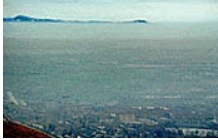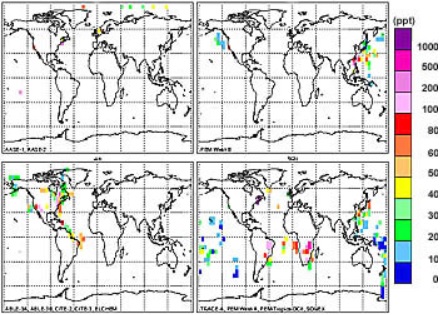Nearly everyone has heard of ozone in at least one of two contexts. One is the "ozone hole" over the Antarctic. The other context is ozone as a chief component of air pollution closer to the ground, especially in cities.
Because of the complexities of the subject and the scattering of sparse data on the issue, it is difficult for atmospheric chemists to determine ozone concentrations in the atmosphere. One scientist has now compiled data on reactive nitrogen species — a chemical precursor to ozone — to map out its global distribution and concentrations.
University of Michigan postdoc Louisa K. Emmons — now a visitor at the National Center for Atmospheric Research in Boulder, Colorado — began her research career on the ozone hole, then moved on to air pollution. "My graduate work had been in stratospheric chemistry looking at the Antarctic ozone hole. I was interested in moving into tropospheric chemistry, and this seemed a good way to jump in and learn."
The troposphere is that portion of the atmosphere closest to the Earth's surface, up to about 11 miles above the Earth at the equator and eight miles at the poles. Ozone is not directly emitted but is photochemically produced from other processes. In the upper atmosphere, the ozone layer protects life on Earth from intense radiation from the sun. But in the troposphere close to the Earth it has harmful effects on humans and damages plants and crops.
"Understanding nitrogen oxide distributions is important to understanding the production of ozone," Emmons says. Nitrogen oxides (NOx) are composed of nitric oxide (NO) plus nitrogen dioxide (NO2) and both are precursors of ozone creation in the troposphere. An important component of air pollution, nitrogen oxides cause the brown color in the pollution cloud seen over so many cities. "To understand how to control the ozone levels, we have to understand which of the precursors need to be controlled," Emmons says.
To map chemical distributions, Emmons compiled data from 28 field research campaigns, then sorted data by season and altitude to make climatologies. (Here, "climatologies" refers to examinations of the evolution of a given parameter—in this case, NOx—at different places over a long time period.) The climatologies showed where measurements were lacking that, were they obtained, could answer questions about photochemistry and tropospheric nitric oxide production and transport, and consequently ozone production, Emmons says. ("Photochemistry" is the study of the impact of light on certain chemical molecules.)
"Current measurements are still far from providing a global view of nitrogen oxide distributions. Some of the most obvious gaps are over Europe, Asia, Australia and the polar regions."
"Another reason to put together these climatologies is for comparison with predictions from global models, as a way of validating the models," Emmons says. She found generally good, if rough, agreement of various global climate models with observed concentrations of total reactive nitrogen species. Many points of disagreement between various computer model predictions were over areas in which there were data gaps, she says, making interpretation difficult.
None of the models, she said, were either always lower or always higher than other models in their predictions. Because all of the models are so different, much more detailed study is required to understand them.
Emmons said, "The models also have different emission scenarios. That can also cause differences between the model and the observation. For a general study like this, it is hard to generalize about what would cause the differences."
The real value of her work, she said, is in providing a baseline of broadly based data to measure changes over time. Emmons said, "I'm not sure I've found anything new, because these are data sets that have all been previously studied and published. I've provided a way to look at all of the data at once, which gives a picture of seasonal variations and variations across the globe.
"There isn't really enough data to say if things have been changing over time. The data are so sparse, it is hard to compare for trends. My work might be a baseline for trend comparison."
References
Emmons, L. K., M. A. Carroll, D. A. Hauglustaine, G. P. Brasseur, C. Atherton, J. Penner, S. Sillman, H. Levy II, F. Rohrer, W. M. F. Wauben, P. F. J. Van Velthoven, Y. Wang, D. Jacob, P. Bakwin, R. Dickerson, B. Doddridge, C. Gerbig, R. Honrath, G. Hubler, D. Jaffe, Y. Kondo, J. W. Munger, A. Torres, and A. Volz-Thomas. 1997. Climatologies of NOx and NOy: A comparison of data and models. Atmospheric Environment 31: 1851-1904.
For more information
NASA Atmospheric Science Data Center (ASDC)
| About the remote sensing data used | ||
|---|---|---|
| Sensor | Global Tropospheric Experiment (GTE) | |
| Parameter | Ozone (O3) | |
| DAAC | NASA Atmospheric Science Data Center (ASDC) | |


